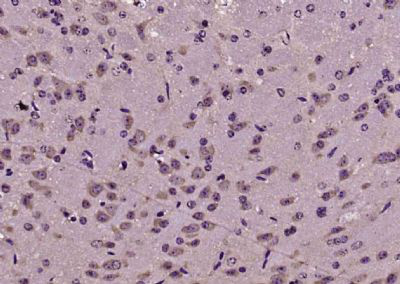产品货号 : mlR11986
英文名称 : CABP1
中文名称 : 钙结合蛋白1抗体
别 名 : CABP 1; CABP1; CABP-1; CABP1_HUMAN; Calbrain; Calcium binding protein 1; Calcium binding protein 5; Calcium-binding protein 1; Caldendrin; HCALB BR; HCALB_BR.
研究领域 : 细胞生物 神经生物学 信号转导 结合蛋白
抗体来源 : Rabbit
克隆类型 : Polyclonal
交叉反应 : Human, Mouse, Rat, Pig, Cow, Horse, Rabbit, Sheep,
产品应用 : ELISA=1:500-1000 IHC-P=1:400-800 IHC-F=1:400-800 ICC=1:100-500 IF=1:100-500 (石蜡切片需做抗原修复)
not yet tested in other applications.
optimal dilutions/concentrations should be determined by the end user.
分 子 量 : 40kDa
细胞定位 : 细胞浆 细胞膜
性 状 : Lyophilized or Liquid
浓 度 : 1mg/ml
免 疫 原 : KLH conjugated synthetic peptide derived from human CABP1:311-355/370
亚 型 : IgG
纯化方法 : affinity purified by Protein A
储 存 液 : 0.01M TBS(pH7.4) with 1% BSA, 0.03% Proclin300 and 50% Glycerol.
保存条件 : Store at -20 °C for one year. Avoid repeated freeze/thaw cycles. The lyophilized antibody is stable at room temperature for at least one month and for greater than a year when kept at -20°C. When reconstituted in sterile pH 7.4 0.01M PBS or diluent of antibody the antibody is stable for at least two weeks at 2-4 °C.
PubMed : PubMed
产品介绍 : Calcium plays an essential role in many biological processes. The calcium binding protein (CaBP) family shares much similarity to calmodulin. It has been shown that CaBP proteins can substitute functionally for, and probably augment the function of, calmodulin. Calcium binding proteins are a crucial part of calcium mediated cellular signal transduction in the central nervous system. There are several members of the family with varying expression patterns. CaBP1 and CaBP2 can be expressed as multiple, alternatively spliced variants in brain and retina. CaBP3, CaBP4 and CaBP 5 are restricted to retinal rod and cone cells. CaBP7 shares 70% homology with CaBP8 and 50% homology with CaM I.
Function:
Modulates calcium-dependent activity of inositol 1,4,5-triphosphate receptors (ITPRs). Inhibits agonist-induced intracellular calcium signaling. Enhances inactivation and does not support calcium-dependent facilitation of voltage-dependent P/Q-type calcium channels. Causes calcium-dependent facilitation and inhibits inactivation of L-type calcium channels by binding to the same sites as calmodulin in the C-terminal domain of CACNA1C, but resulting in an opposit effects on channel function. Suppresses the calcium-dependent inactivation of CACNA1D (By similarity). Inhibits TRPC5 channels. Prevents NMDA receptor-induced cellular degeneration.
Subunit:
Homodimer; when bound to calcium or magnesium. Interacts (via C-terminus) with ITPR1, ITPR2 and ITPR3. This binding is calcium dependent and the interaction correlates with calcium concentration. An additional calcium-independent interaction with the N-terminus of ITPR1 results in a decreased InsP(3) binding to the receptor. Interacts with CACNA1A (via C-terminal CDB motif) in the pre- and postsynaptic membranes. Interacts with CACNA1C (via C-terminal C and IQ motifs). The binding to the C motif is calcium independent whereas the binding to IQ requires the presence of calcium and is mutually exclusive with calmodulin binding. Interacts with CACNA1D (By similarity). Interacts with TRPC5 (via C-terminus). Interacts (via EF-hands 1 and 2) at microtubules with MAP1LC3B. Interacts with MYO1C and NELF
Subcellular Location:
Cytoplasm, cytoskeleton. Cytoplasm, perinuclear region. Cell membrane; Lipid-anchor; Cytoplasmic side. Golgi apparatus. Cell junction, synapse, postsynaptic cell membrane, postsynaptic density. Note=L-CaBP1 is associated most likely with the cytoskeletal structures, whereas S-CaBP1 is localized at or near the plasma membrane.
Tissue Specificity:
Retina and brain. Somatodendritic compartment of neurons. Calbrain was found exclusively in brain where it is abundant in the hippocampus, habenular area in the epithalamus and in the cerebellum.
Post-translational modifications:
Phosphorylated. The phosphorylation regulates the activity.
Similarity:
Contains 4 EF-hand domains.
SWISS:
Q9NZU7
Gene ID:
9478
Important Note:
This product as supplied is intended for research use only, not for use in human, therapeutic or diagnostic applications.
产品图片












